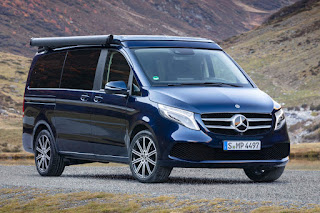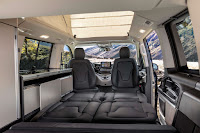A facelift for the Marco Polo camper van
Mercedes-Benz has announced some updates for the V-Class people carrier and its offshoots, the Marco Polo camper van and Marco Polo Horizon leisure vehicle.
Visually, the changes are limited to a restyled front bumper, a modified grille and some new wheel designs. The interior revisions are similarly hard to spot, as they consist of different air vents and instrument graphics.
More important are the powertrain improvements, which centre around the introduction of a 2.0 litre, four-cylinder engine. In range-topping V 300 d guise, this diesel unit delivers 235 bhp (176 kW / 239 PS) to the rear wheels via a three-mode, nine-speed automatic transmission. Although peak torque is usually 500 Nm (368 lb/ft), that can rise briefly to 530 Nm (390 lb/ft) on overboost.
A 0-62 mph (100 km/h) time of 7.9 seconds and a 136 mph (220 km/h) top speed both indicate decent performance. Combined-cycle fuel economy for the Marco Polo varies between 41.6 mpg (6.8 l/100km) and 46.3mpg (6.1 l/100km), while CO2 emissions are 180 g/km to 160 g/km.
Incidentally, the regular V-Class is slightly more efficient. It records equivalent figures of 44.9 mpg (6.3 l/100km) to 47.9 mpg (5.9 l/100km) and 165 g/km to 154 g/km respectively.
Additional driver aids are now fitted, too. Highbeam Assist Plus becomes standard, as does the very useful Active Brake Assist.
Mercedes-Benz dealers will start accepting 2019 V-Class, Marco Polo and Marco Polo Horizon orders next month.
Related posts:
The Marco Polo Horizon is all about flexibility
Mercedes reveals the Marco Polo camper van
Visually, the changes are limited to a restyled front bumper, a modified grille and some new wheel designs. The interior revisions are similarly hard to spot, as they consist of different air vents and instrument graphics.
More important are the powertrain improvements, which centre around the introduction of a 2.0 litre, four-cylinder engine. In range-topping V 300 d guise, this diesel unit delivers 235 bhp (176 kW / 239 PS) to the rear wheels via a three-mode, nine-speed automatic transmission. Although peak torque is usually 500 Nm (368 lb/ft), that can rise briefly to 530 Nm (390 lb/ft) on overboost.
A 0-62 mph (100 km/h) time of 7.9 seconds and a 136 mph (220 km/h) top speed both indicate decent performance. Combined-cycle fuel economy for the Marco Polo varies between 41.6 mpg (6.8 l/100km) and 46.3mpg (6.1 l/100km), while CO2 emissions are 180 g/km to 160 g/km.
Incidentally, the regular V-Class is slightly more efficient. It records equivalent figures of 44.9 mpg (6.3 l/100km) to 47.9 mpg (5.9 l/100km) and 165 g/km to 154 g/km respectively.
Additional driver aids are now fitted, too. Highbeam Assist Plus becomes standard, as does the very useful Active Brake Assist.
Mercedes-Benz dealers will start accepting 2019 V-Class, Marco Polo and Marco Polo Horizon orders next month.
Related posts:
The Marco Polo Horizon is all about flexibility
Mercedes reveals the Marco Polo camper van







%2BDashboard.jpg)

+Front+Side.jpg)

+Front+Side.jpg)

Comments
Post a Comment